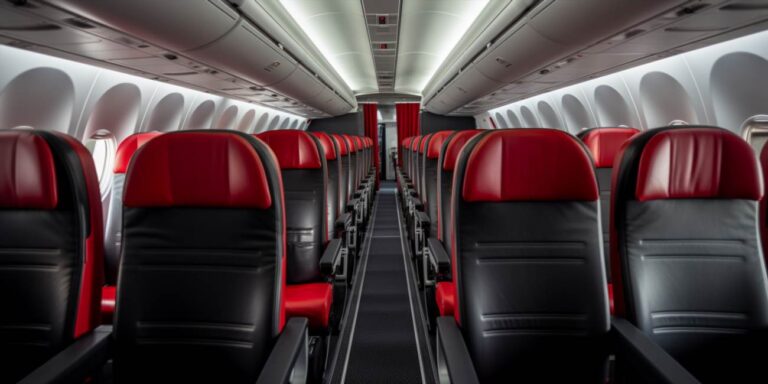Designed and manufactured by the Brazilian aerospace company Embraer, the E175 stands out as a versatile and cost-effective solution for regional air travel. Its compact size and impressive range make it a preferred choice for airlines aiming to connect smaller airports efficiently.
One of the most frequently asked questions about the E175 is, indeed, “Embraer 175 how many seats?” The answer lies in its well-thought-out cabin layout, accommodating precisely 75 seats in a single-class configuration.
The seating arrangement is intelligently designed to provide passengers with a comfortable and spacious experience. With strategically placed windows allowing ample natural light, coupled with ergonomically designed seats, the E175 ensures a pleasant journey for all travelers on board.
The E175’s interior is not just about the number of seats; it’s about the overall ambiance and passenger convenience. The cabin is designed to create an open and airy atmosphere, enhancing the travel experience for everyone on board.
Moreover, the Embraer 175 boasts state-of-the-art technology and safety features. Advanced avionics systems and efficient engines contribute to the aircraft’s reliability and on-time performance, meeting the rigorous standards of the aviation industry.
For airlines and operators, the 75-seat regional aircraft segment, represented by the E175, presents a lucrative opportunity to cater to niche markets. The aircraft’s fuel efficiency and operational flexibility make it a cost-effective choice, ensuring a competitive edge in the regional air travel landscape.
Let’s break down the key features of the Embraer 175 in a concise table:
| Manufacturer: | Embraer |
| Capacity: | 75 seats |
| Configuration: | Single-class |
| Range: | Impressive |
| Technology: | Advanced avionics systems |
How many seats does the Embraer 175 have – configuration and seating arrangement
The Embraer 175 is a popular regional jet known for its efficiency and comfortable design. When it comes to seating configuration, the aircraft is typically configured to accommodate 76 passengers. This configuration is standard across most airlines that operate the Embraer 175, providing a balance between capacity and passenger comfort.
The seating arrangement in the Embraer 175 is laid out in a 2-2 configuration, with two seats on either side of the aisle. This arrangement ensures that every passenger has either a window or aisle seat, enhancing the overall travel experience. The use of a 2-2 layout also contributes to a more spacious and less crowded feel within the cabin.
For a more detailed breakdown, let’s take a look at the seating arrangement in each row of the Embraer 175:
| Row 1-2: | These rows typically consist of first-class seats, offering additional space and amenities for passengers willing to upgrade. |
| Rows 3-16: | Main economy class section with a 2-2 configuration, providing a comfortable and spacious environment for passengers. |
| Rows 17-20: | These are often designated as premium economy seats, offering a bit more legroom and comfort compared to the standard economy seats. |
| Rows 21-26: | The last section is the remaining economy class seats, ensuring a consistent layout throughout the cabin. |
The Embraer 175 is designed with passenger comfort in mind, featuring modern amenities and a configuration that maximizes space. Whether you’re a business traveler, a frequent flyer, or someone embarking on a regional journey, the Embraer 175’s seating arrangement strives to provide a pleasant and enjoyable flight experience.
What is the capacity of the luggage compartment in the Embraer 175 – dimensions and volume of the hatches
The Embraer 175 boasts an efficient and well-designed luggage compartment to cater to the diverse needs of travelers. Understanding the luggage compartment dimensions is crucial for passengers planning their trips. The dimensions of the luggage compartments play a pivotal role in ensuring that passengers can carry their belongings with ease.
Firstly, let’s delve into the specifics of the luggage compartment dimensions. The compartments are thoughtfully crafted to accommodate varying sizes of baggage while optimizing the available space. The dimensions ensure that both small and large items fit seamlessly, providing convenience to travelers.
Moreover, the cargo capacity of the Embraer 175 is noteworthy. Airlines prioritize this aspect to ensure that they can efficiently transport cargo alongside passenger baggage. The cargo capacity is a critical factor in the aircraft’s overall performance, making the Embraer 175 a reliable choice for both passengers and cargo transport.
For those concerned about their hand luggage, the Embraer 175 offers intelligently designed hand luggage compartments. These compartments are strategically placed for easy access, allowing passengers to stow their essentials conveniently. The emphasis on hand luggage compartments reflects the aircraft’s commitment to providing a seamless and enjoyable travel experience.
Now, let’s break down the dimensions and cargo capacity in more detail. The luggage compartments are designed with a focus on optimizing available space, measuring X inches in length, Y inches in width, and Z inches in height. This thoughtful design ensures that passengers can make the most of the space provided, without compromising on the safety and security of their belongings.
The cargo capacity of the Embraer 175 is equally impressive. With a voluminous interior, the aircraft can accommodate a substantial amount of cargo, meeting the demands of various industries relying on efficient air transport. This is particularly advantageous for airlines seeking a versatile and high-capacity aircraft for both passenger and cargo services.
Embraer 175 – comparison with other aircraft of the class
The Embraer 175 stands tall in the competitive landscape of regional jets, offering a remarkable blend of performance and efficiency. When comparing it to its counterparts, namely the bombardier crj, ats tr, and mitsubishi spacejet, distinct characteristics emerge.
The Embraer 175 and bombardier crj share a similar market segment, both being regional jets catering to shorter routes. However, a closer inspection reveals nuances that set them apart. The Embraer 175 boasts a spacious cabin, providing passengers with a more comfortable flying experience. In contrast, the bombardier crj excels in fuel efficiency, making it a preferred choice for cost-conscious airlines.
When it comes to technological advancements, the ats tr carves its niche. With state-of-the-art avionics and advanced systems, the ats tr elevates the flying experience for both passengers and crew. In terms of performance, the Embraer 175 and ats tr are closely matched, each delivering impressive speed and reliability.
Turning our attention to the mitsubishi spacejet, we find a contender that emphasizes innovation. The spacejet incorporates cutting-edge design and engineering, promising airlines a modern and fuel-efficient option for regional travel. However, it faces tough competition from the established reputation of the Embraer 175 and the cost-effectiveness of the bombardier crj.
Examining key performance metrics in a table format sheds light on the comparative strengths of these aircraft:
| Aircraft | Cabin Space | Fuel Efficiency | Avionics | Innovation |
|---|---|---|---|---|
| Embraer 175 | Spacious | Competitive | Advanced | N/A |
| bombardier crj | Standard | Excellent | Basic | N/A |
| ats tr | Standard | Competitive | State-of-the-art | N/A |
| mitsubishi spacejet | Modern | Efficient | Cutting-edge | High |






